run flat CHEVROLET VOLT 2011 Owner's Manual
[x] Cancel search | Manufacturer: CHEVROLET, Model Year: 2011, Model line: VOLT, Model: CHEVROLET VOLT 2011Pages: 516, PDF Size: 6.61 MB
Page 24 of 516
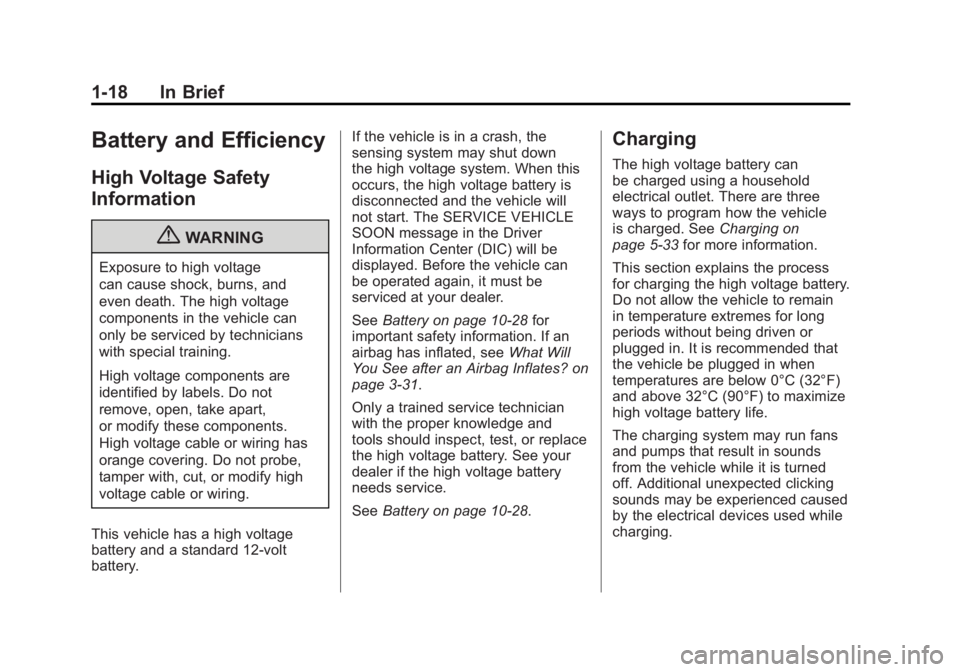
Black plate (18,1)Chevrolet Volt Owner Manual - 2011
1-18 In Brief
Battery and Efficiency
High Voltage Safety
Information
{WARNING
Exposure to high voltage
can cause shock, burns, and
even death. The high voltage
components in the vehicle can
only be serviced by technicians
with special training.
High voltage components are
identified by labels. Do not
remove, open, take apart,
or modify these components.
High voltage cable or wiring has
orange covering. Do not probe,
tamper with, cut, or modify high
voltage cable or wiring.
This vehicle has a high voltage
battery and a standard 12‐volt
battery. If the vehicle is in a crash, the
sensing system may shut down
the high voltage system. When this
occurs, the high voltage battery is
disconnected and the vehicle will
not start. The SERVICE VEHICLE
SOON message in the Driver
Information Center (DIC) will be
displayed. Before the vehicle can
be operated again, it must be
serviced at your dealer.
See
Battery on page 10‑28 for
important safety information. If an
airbag has inflated, see What Will
You See after an Airbag Inflates? on
page 3‑31.
Only a trained service technician
with the proper knowledge and
tools should inspect, test, or replace
the high voltage battery. See your
dealer if the high voltage battery
needs service.
See Battery on page 10‑28.
Charging
The high voltage battery can
be charged using a household
electrical outlet. There are three
ways to program how the vehicle
is charged. See Charging on
page 5‑33 for more information.
This section explains the process
for charging the high voltage battery.
Do not allow the vehicle to remain
in temperature extremes for long
periods without being driven or
plugged in. It is recommended that
the vehicle be plugged in when
temperatures are below 0°C (32°F)
and above 32°C (90°F) to maximize
high voltage battery life.
The charging system may run fans
and pumps that result in sounds
from the vehicle while it is turned
off. Additional unexpected clicking
sounds may be experienced caused
by the electrical devices used while
charging.
Page 147 of 516
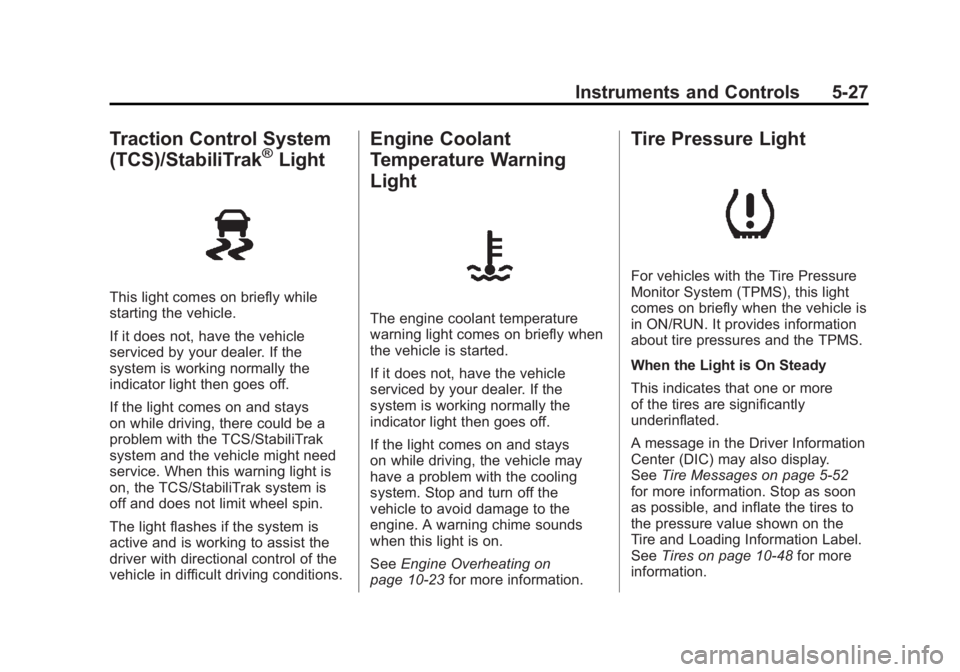
Black plate (27,1)Chevrolet Volt Owner Manual - 2011
Instruments and Controls 5-27
Traction Control System
(TCS)/StabiliTrak®Light
This light comes on briefly while
starting the vehicle.
If it does not, have the vehicle
serviced by your dealer. If the
system is working normally the
indicator light then goes off.
If the light comes on and stays
on while driving, there could be a
problem with the TCS/StabiliTrak
system and the vehicle might need
service. When this warning light is
on, the TCS/StabiliTrak system is
off and does not limit wheel spin.
The light flashes if the system is
active and is working to assist the
driver with directional control of the
vehicle in difficult driving conditions.
Engine Coolant
Temperature Warning
Light
The engine coolant temperature
warning light comes on briefly when
the vehicle is started.
If it does not, have the vehicle
serviced by your dealer. If the
system is working normally the
indicator light then goes off.
If the light comes on and stays
on while driving, the vehicle may
have a problem with the cooling
system. Stop and turn off the
vehicle to avoid damage to the
engine. A warning chime sounds
when this light is on.
SeeEngine Overheating on
page 10‑23 for more information.
Tire Pressure Light
For vehicles with the Tire Pressure
Monitor System (TPMS), this light
comes on briefly when the vehicle is
in ON/RUN. It provides information
about tire pressures and the TPMS.
When the Light is On Steady
This indicates that one or more
of the tires are significantly
underinflated.
A message in the Driver Information
Center (DIC) may also display.
SeeTire Messages on page 5‑52
for more information. Stop as soon
as possible, and inflate the tires to
the pressure value shown on the
Tire and Loading Information Label.
See Tires on page 10‑48 for more
information.
Page 306 of 516
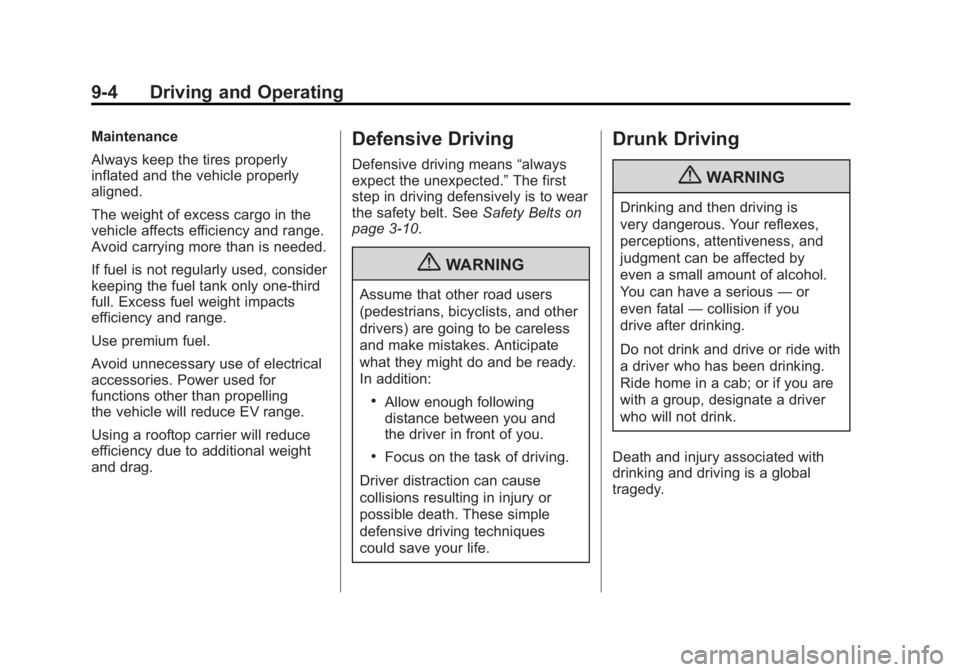
Black plate (4,1)Chevrolet Volt Owner Manual - 2011
9-4 Driving and Operating
Maintenance
Always keep the tires properly
inflated and the vehicle properly
aligned.
The weight of excess cargo in the
vehicle affects efficiency and range.
Avoid carrying more than is needed.
If fuel is not regularly used, consider
keeping the fuel tank only one‐third
full. Excess fuel weight impacts
efficiency and range.
Use premium fuel.
Avoid unnecessary use of electrical
accessories. Power used for
functions other than propelling
the vehicle will reduce EV range.
Using a rooftop carrier will reduce
efficiency due to additional weight
and drag.Defensive Driving
Defensive driving means“always
expect the unexpected.” The first
step in driving defensively is to wear
the safety belt. See Safety Belts on
page 3‑10.
{WARNING
Assume that other road users
(pedestrians, bicyclists, and other
drivers) are going to be careless
and make mistakes. Anticipate
what they might do and be ready.
In addition:
.Allow enough following
distance between you and
the driver in front of you.
.Focus on the task of driving.
Driver distraction can cause
collisions resulting in injury or
possible death. These simple
defensive driving techniques
could save your life.
Drunk Driving
{WARNING
Drinking and then driving is
very dangerous. Your reflexes,
perceptions, attentiveness, and
judgment can be affected by
even a small amount of alcohol.
You can have a serious —or
even fatal —collision if you
drive after drinking.
Do not drink and drive or ride with
a driver who has been drinking.
Ride home in a cab; or if you are
with a group, designate a driver
who will not drink.
Death and injury associated with
drinking and driving is a global
tragedy.
Page 437 of 516
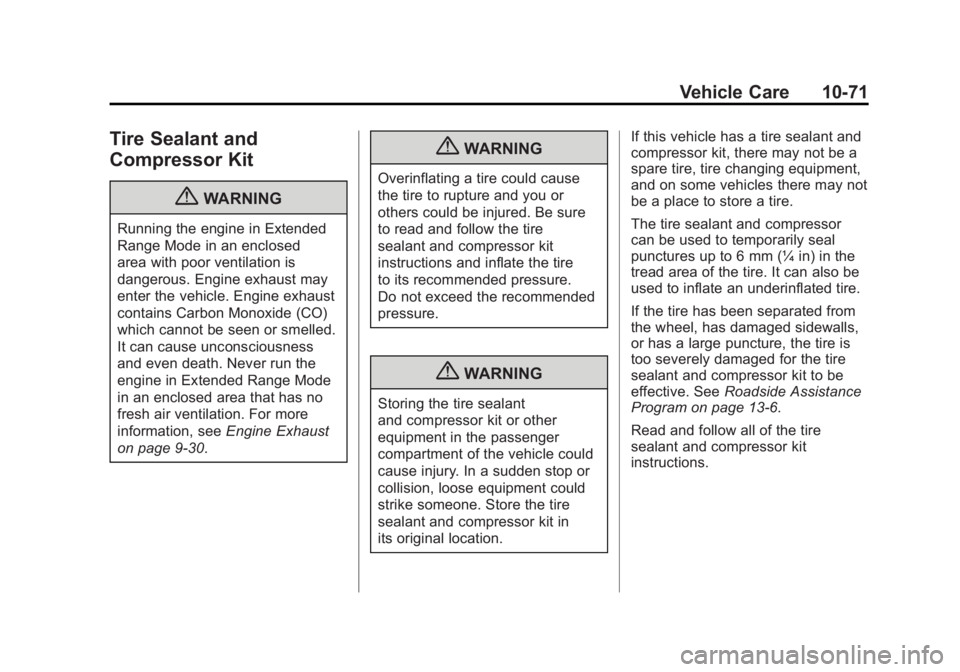
Black plate (71,1)Chevrolet Volt Owner Manual - 2011
Vehicle Care 10-71
Tire Sealant and
Compressor Kit
{WARNING
Running the engine in Extended
Range Mode in an enclosed
area with poor ventilation is
dangerous. Engine exhaust may
enter the vehicle. Engine exhaust
contains Carbon Monoxide (CO)
which cannot be seen or smelled.
It can cause unconsciousness
and even death. Never run the
engine in Extended Range Mode
in an enclosed area that has no
fresh air ventilation. For more
information, seeEngine Exhaust
on page 9‑30.
{WARNING
Overinflating a tire could cause
the tire to rupture and you or
others could be injured. Be sure
to read and follow the tire
sealant and compressor kit
instructions and inflate the tire
to its recommended pressure.
Do not exceed the recommended
pressure.
{WARNING
Storing the tire sealant
and compressor kit or other
equipment in the passenger
compartment of the vehicle could
cause injury. In a sudden stop or
collision, loose equipment could
strike someone. Store the tire
sealant and compressor kit in
its original location. If this vehicle has a tire sealant and
compressor kit, there may not be a
spare tire, tire changing equipment,
and on some vehicles there may not
be a place to store a tire.
The tire sealant and compressor
can be used to temporarily seal
punctures up to 6 mm (¼ in) in the
tread area of the tire. It can also be
used to inflate an underinflated tire.
If the tire has been separated from
the wheel, has damaged sidewalls,
or has a large puncture, the tire is
too severely damaged for the tire
sealant and compressor kit to be
effective. See
Roadside Assistance
Program on page 13‑6.
Read and follow all of the tire
sealant and compressor kit
instructions.
Page 440 of 516
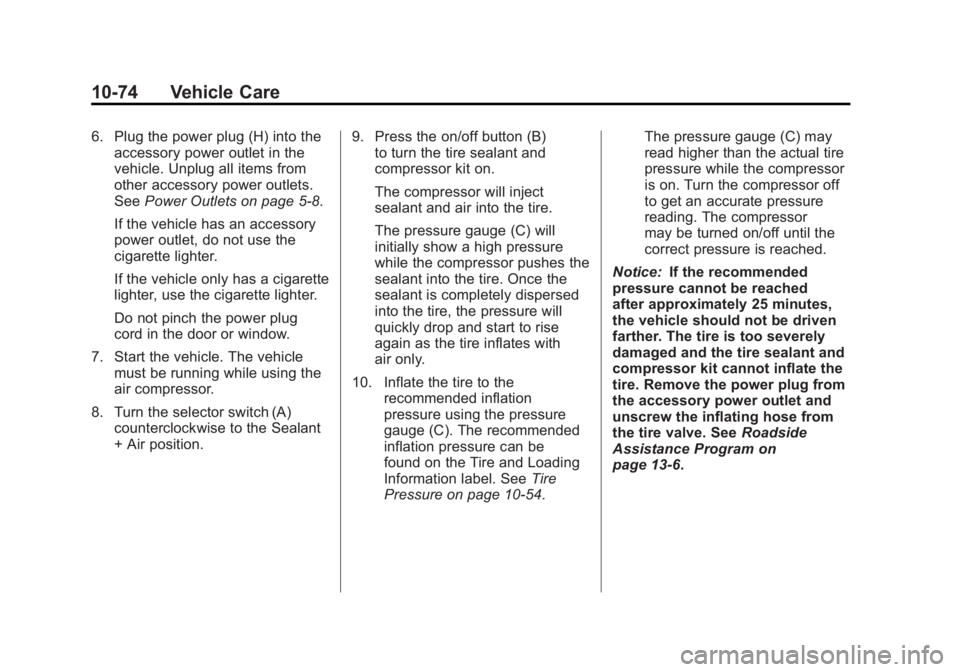
Black plate (74,1)Chevrolet Volt Owner Manual - 2011
10-74 Vehicle Care
6. Plug the power plug (H) into theaccessory power outlet in the
vehicle. Unplug all items from
other accessory power outlets.
See Power Outlets on page 5‑8.
If the vehicle has an accessory
power outlet, do not use the
cigarette lighter.
If the vehicle only has a cigarette
lighter, use the cigarette lighter.
Do not pinch the power plug
cord in the door or window.
7. Start the vehicle. The vehicle must be running while using the
air compressor.
8. Turn the selector switch (A) counterclockwise to the Sealant
+ Air position. 9. Press the on/off button (B)
to turn the tire sealant and
compressor kit on.
The compressor will inject
sealant and air into the tire.
The pressure gauge (C) will
initially show a high pressure
while the compressor pushes the
sealant into the tire. Once the
sealant is completely dispersed
into the tire, the pressure will
quickly drop and start to rise
again as the tire inflates with
air only.
10. Inflate the tire to the recommended inflation
pressure using the pressure
gauge (C). The recommended
inflation pressure can be
found on the Tire and Loading
Information label. See Tire
Pressure on page 10‑54. The pressure gauge (C) may
read higher than the actual tire
pressure while the compressor
is on. Turn the compressor off
to get an accurate pressure
reading. The compressor
may be turned on/off until the
correct pressure is reached.
Notice: If the recommended
pressure cannot be reached
after approximately 25 minutes,
the vehicle should not be driven
farther. The tire is too severely
damaged and the tire sealant and
compressor kit cannot inflate the
tire. Remove the power plug from
the accessory power outlet and
unscrew the inflating hose from
the tire valve. See Roadside
Assistance Program on
page 13‑6.
Page 443 of 516
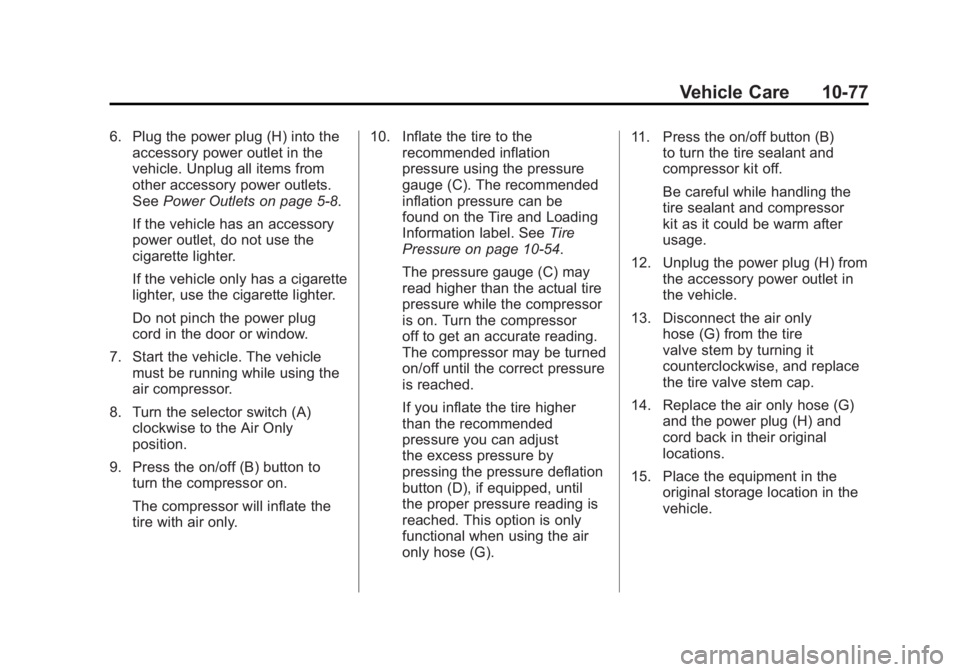
Black plate (77,1)Chevrolet Volt Owner Manual - 2011
Vehicle Care 10-77
6. Plug the power plug (H) into theaccessory power outlet in the
vehicle. Unplug all items from
other accessory power outlets.
See Power Outlets on page 5‑8.
If the vehicle has an accessory
power outlet, do not use the
cigarette lighter.
If the vehicle only has a cigarette
lighter, use the cigarette lighter.
Do not pinch the power plug
cord in the door or window.
7. Start the vehicle. The vehicle must be running while using the
air compressor.
8. Turn the selector switch (A) clockwise to the Air Only
position.
9. Press the on/off (B) button to turn the compressor on.
The compressor will inflate the
tire with air only. 10. Inflate the tire to the
recommended inflation
pressure using the pressure
gauge (C). The recommended
inflation pressure can be
found on the Tire and Loading
Information label. See Tire
Pressure on page 10‑54.
The pressure gauge (C) may
read higher than the actual tire
pressure while the compressor
is on. Turn the compressor
off to get an accurate reading.
The compressor may be turned
on/off until the correct pressure
is reached.
If you inflate the tire higher
than the recommended
pressure you can adjust
the excess pressure by
pressing the pressure deflation
button (D), if equipped, until
the proper pressure reading is
reached. This option is only
functional when using the air
only hose (G). 11. Press the on/off button (B)
to turn the tire sealant and
compressor kit off.
Be careful while handling the
tire sealant and compressor
kit as it could be warm after
usage.
12. Unplug the power plug (H) from the accessory power outlet in
the vehicle.
13. Disconnect the air only hose (G) from the tire
valve stem by turning it
counterclockwise, and replace
the tire valve stem cap.
14. Replace the air only hose (G) and the power plug (H) and
cord back in their original
locations.
15. Place the equipment in the original storage location in the
vehicle.
Page 450 of 516
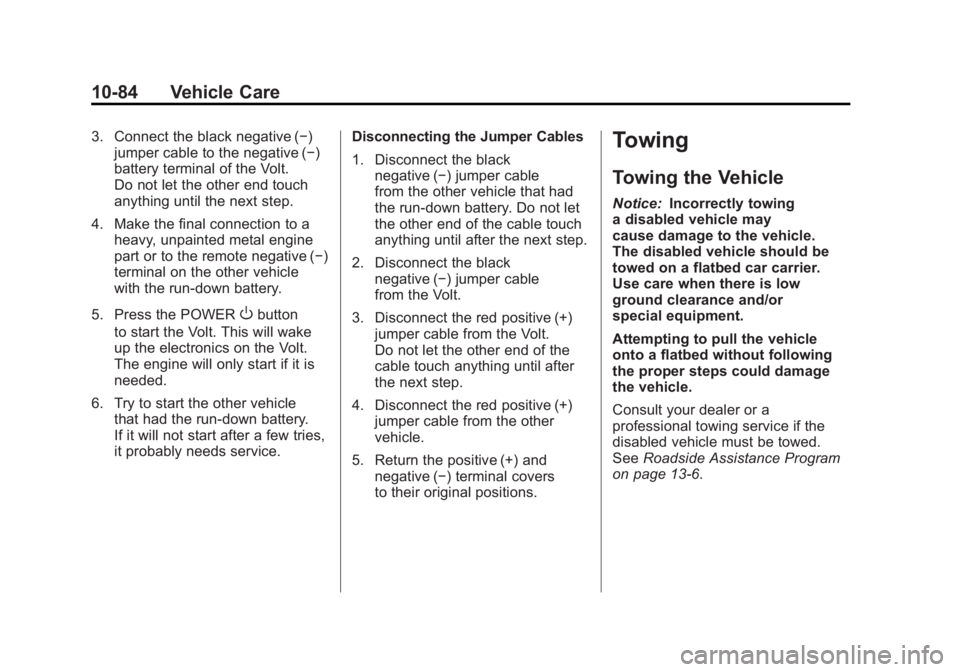
Black plate (84,1)Chevrolet Volt Owner Manual - 2011
10-84 Vehicle Care
3. Connect the black negative (−)jumper cable to the negative (−)
battery terminal of the Volt.
Do not let the other end touch
anything until the next step.
4. Make the final connection to a heavy, unpainted metal engine
part or to the remote negative (−)
terminal on the other vehicle
with the run‐down battery.
5. Press the POWER
Obutton
to start the Volt. This will wake
up the electronics on the Volt.
The engine will only start if it is
needed.
6. Try to start the other vehicle that had the run‐down battery.
If it will not start after a few tries,
it probably needs service. Disconnecting the Jumper Cables
1. Disconnect the black
negative (−) jumper cable
from the other vehicle that had
the run‐down battery. Do not let
the other end of the cable touch
anything until after the next step.
2. Disconnect the black negative (−) jumper cable
from the Volt.
3. Disconnect the red positive (+) jumper cable from the Volt.
Do not let the other end of the
cable touch anything until after
the next step.
4. Disconnect the red positive (+) jumper cable from the other
vehicle.
5. Return the positive (+) and negative (−) terminal covers
to their original positions.
Towing
Towing the Vehicle
Notice: Incorrectly towing
a disabled vehicle may
cause damage to the vehicle.
The disabled vehicle should be
towed on a flatbed car carrier.
Use care when there is low
ground clearance and/or
special equipment.
Attempting to pull the vehicle
onto a flatbed without following
the proper steps could damage
the vehicle.
Consult your dealer or a
professional towing service if the
disabled vehicle must be towed.
See Roadside Assistance Program
on page 13‑6.
Page 508 of 516

Black plate (4,1)Chevrolet Volt Owner Manual - 2011
i-4 INDEX
E
Electric Drive Unit . . . . . . . . . . . . . 9-32
Electric Drive UnitMessages . . . . . . . . . . . . . . . . . . . . 5-47
Electric Drive Unit Shift Lock Control Function
Check . . . . . . . . . . . . . . . . . . . . . . . 10-30
Electric Mode . . . . . . . . . . . . . . . . . . 9-25
Electric Parking Brake . . . . . . . . . 9-35
Electric Parking Brake Light . . . 5-25
Electrical Equipment, Add-On . . . . . . . . . . . . . . . . . . . . . . 9-63
Electrical Requirements for Battery Charging . . . . . . . . . . . . . 9-56
Electrical System Engine Compartment
Fuse Block . . . . . . . . . . . . . . . . 10-38
Instrument Panel Fuse Block . . . . . . . . . 10-42, 10-43
Overload . . . . . . . . . . . . . . . . . . . 10-37
Rear Compartment Fuse
Block . . . . . . . . . . . . . . . . . . . . . . 10-45
Electronic Stability Control . . . . . 9-39
Energy Efficiency Driving . . . . . . . . . . . . . . . . . . . 1-25, 9-2
Energy Information . . . . . . . . . . . . 5-41 Engine
Air Cleaner/Filter . . . . . . . . . . . 10-16
Check and Service Engine
Soon Light . . . . . . . . . . . . . . . . . . 5-21
Compartment Overview . . . . . 10-10
Coolant . . . . . . . . . . . . . . . . . . . . . 10-21
Coolant Temperature Warning Light . . . . . . . . . . . . . . . 5-27
Cooling System . . . . . . 10-18, 10-20
Cooling System Messages . . . 5-47
Drive Belt Routing . . . . . . . . . . . . 12-3
Exhaust . . . . . . . . . . . . . . . . . . . . . . 9-30
Overheating . . . . . . . . . . . . . . . . 10-23
Pressure Light . . . . . . . . . . . . . . . . 5-28
Running While Parked . . . . . . . . 9-31
Engine Oil
Life System . . . . . . . . . . . . . . . . . 10-15
Messages . . . . . . . . . . . . . . . . . . . . 5-48
Engine Unavailable Out of Fuel . . . . . . . . . . . . . . . . . . . 9-28
Entry Lighting . . . . . . . . . . . . . . . . . . . 6-5
Event Data Recorders . . . . . . . . 13-26
Exit Lighting . . . . . . . . . . . . . . . . . . . . 6-6
Extended Range Mode . . . . . . . . 9-25
Extender, Safety Belt . . . . . . . . . . 3-23
Exterior Lamp Controls . . . . . . . . . 6-1
F
Filter,
Engine Air Cleaner . . . . . . . . . 10-16
Flash-to-Pass . . . . . . . . . . . . . . . . . . . 6-2
Flashers, Hazard Warning . . . . . . 6-4
Flat Tire . . . . . . . . . . . . . . . . . . . . . . 10-69
Floor Console Storage . . . . . . . . . . 4-1
Floor Mats . . . . . . . . . . . . . . . . . . . . 10-96
Fluid Brakes . . . . . . . . . . . . . . . . . . . . . . 10-26
Power Steering . . . . . . . . . . . . . 10-24
Washer . . . . . . . . . . . . . . . . . . . . . 10-24
Folding Mirrors . . . . . . . . . . . . . . . . 2-16
Front Seats Adjustment . . . . . . . . . . . . . . . . . . . . 3-4
Heated . . . . . . . . . . . . . . . . . . . . . . . . 3-6
Fuel . . . . . . . . . . . . . . . . . . . . . . . . . . . 9-57 Additives . . . . . . . . . . . . . . . . . . . . . 9-59
Filling a Portable FuelContainer . . . . . . . . . . . . . . . . . . . 9-62
Filling the Tank . . . . . . . . . . . . . . . 9-60
Fuels in Foreign Countries . . . . 9-58
Gasoline Specifications . . . . . . . 9-58
Gauge . . . . . . . . . . . . . . . . . . . . . . . . 5-16